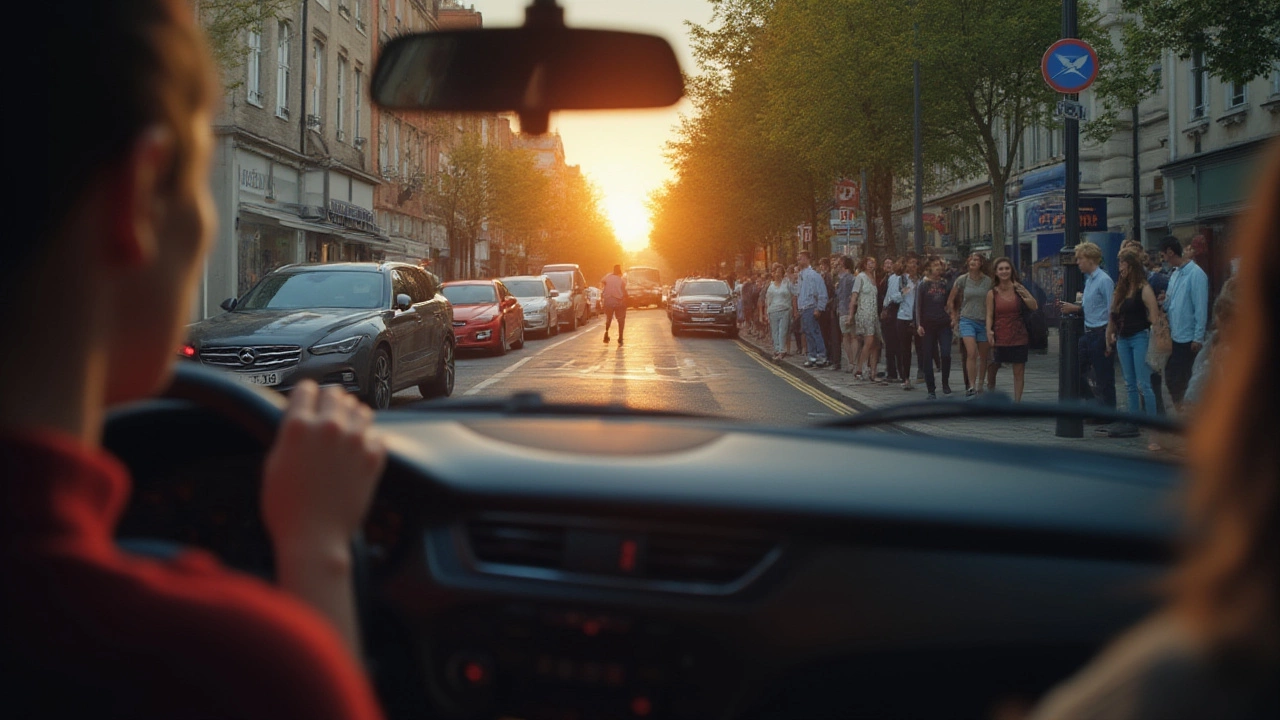Would you hand the keys to a distracted driver, no matter how skilled they are? Most of us wouldn't. Yet distraction, not a lack of skill, causes most crashes. It's easy to think experience or technical know-how ranks highest, but study after study says otherwise. Even a Formula One champion loses his edge if he checks his phone. Driving is full of unpredictable moments—kids sprinting onto the street, cyclists weaving through traffic, or someone slamming the brakes ahead. Staying alive pivots on one thing: attention. People talk about it, but few really practice being truly present in the driver's seat. Our world is stuffed with pings, dings, and countless distractions, both in and out of the car. Most folks overestimate their multitasking prowess—they can handle coffee, music, a phone chat, and driving, right? Wrong. A survey from the UK’s Department for Transport found that over half of accidents in 2023 involved ‘inattention or distraction’ as a factor. Think that’s not you? If you’ve ever missed your exit while deep in thought, you’re proof that even the simplest distractions eat away at your driving focus.
Why Attention Outranks Everything Else on the Road
Let's break down what focus really looks like behind the wheel. Most people believe a spotless driving record means you’re a safe driver. But luck often plays a bigger role than skill or even good habits. Go ahead: ask anyone who’s ever had a close call. They’ll probably say, “I just looked away for a second.” That second is the enemy. Why? Reaction time plummets. Studies published in the journal "Accident Analysis and Prevention" show that glancing at your phone for even two seconds at highway speed means you travel the length of a football field blindfolded. Not dramatic enough? Consider the infamous “invisible gorilla” experiment where people missed a giant ape walking through a basketball game simply because they were mentally busy. Our minds filter out what isn’t at the center of attention, even with eyes wide open. When you’re on the road, you need every sense peeled for clues: the brake lights ahead, the sudden swerve of a bike, that dog bounding out between two cars. Sure, confidence feels good. Complacency, though, sneaks in when we stop treating each drive as the unpredictable event it is.
If you want to stack the odds in your favor, keep a “what if?” loop running—not paranoid, just realistic. “What if that driver doesn’t see me?” “What if the light changes before I get there?” These mini-scenarios keep you ready for surprises. Mental rehearsal, the same technique pro athletes use, actually sharpens your real-world responses. That’s focus in action: it’s not about fearing the road, but expecting it to test you at any second. When you engage like that, you avoid the trap of autopilot. Autopilot lulls you, makes you miss the motorbike in your blind spot or that quiet indicator showing the car in front wants to turn. In the words of transport psychologist Dr. Gemma Briggs, “You don’t drive as well as you think you do. The skill of multitasking while driving is a myth.”
So, how do you make attention your strongest tool? Set rules. Phones go in the glove compartment. Snacks and sips wait for red lights. If your mind wanders—about work, arguments, or grocery lists—pull it back to the present. Some drivers I know talk out loud to themselves, describing what’s ahead (“Silver car changing lanes, green light coming up”). It sounds silly, but research from the University of Sussex found that narrating actions increases awareness and accuracy on the road. Driving, unlike sitting at a desk, is a full-contact mental sport where lapses in focus cost real time, money, and sometimes—lives.
The Hidden Dangers Lurking in Everyday Distractions
Zoom in on the car cabin: it’s basically a distraction factory. Ever seen someone eat a burger with one hand, check GPS with the other, and still steer? People do it all the time. Modern dashboards seduce us with touchscreen controls, Bluetooth-phone calls, and endless music choices. The Royal Society for the Prevention of Accidents (RoSPA) warned that fiddling with the radio takes your eyes off the road for an average of two seconds—just as bad as glancing at your phone, and enough to double your crash risk. Even talking to passengers or singing along to your favorite song chips away at concentration. That’s not to mention kids in the back, spats with your partner, or the ever-present daydreams about work or the weekend.
Then there’s the myth that hands-free means risk-free. It doesn’t. The National Safety Council says hands-free calls are still mentally distracting—even if your gaze stays ahead, your brain’s busy elsewhere. The Center for Cognitive Brain Imaging at Carnegie Mellon University ran brain scans showing that talking while driving reduces the amount of brain activity associated with seeing by up to 37 percent. That’s not a software glitch; it’s your brain’s built-in limits. Those limits matter most in urban areas and unpredictable rush-hour chaos. Any action that splits your focus—whether you think it’s tiny—adds up. Ever missed a road sign entirely, then realized you were too busy changing your playlist? That’s your mind skipping reality to juggle too much.
Habit can be a trap, too. Familiar routes shorten attention spans. You think you know every bend and bump, so you go on “mental cruise control.” But that’s the worst time to relax. Stats from Transport for London show a higher rate of collisions just a few miles from home because drivers feel safest there and let vigilance slip. To fight this, switch up your routine: take a different route sometimes, even if it adds a few minutes. You’ll be more alert just because the new scenery breaks autopilot.
Not all distractions come from devices or noisy passengers. Fatigue works silently. A 2022 RAC Foundation report showed that 1 in 8 serious crashes in the UK involved driver fatigue. Microsleeps—brief dozes lasting just seconds—can happen before you realise you’re tired. Tricks like blasting cold air or slapping your face don’t really work. The only cure is stopping and resting. Even being emotionally upset counts: distraction is just as much about your feelings as about your gadgets. New drivers are especially vulnerable since every new skill requires attention, and if that bandwidth is split, accidents happen fast.

Practical Ways to Sharpen Your Focus Behind the Wheel
Ready to dial in laser focus next time you drive? It starts before you even start the engine. Check your mirrors, seat, and infotainment system—set up everything before moving an inch. Pre-load your playlist, type in the sat-nav destination, and silence notifications. If you’re going on a long trip, break the journey into manageable chunks. Schedule coffee or loo breaks every 90 minutes to avoid autopilot and fatigue. Carry snacks and water, but don’t eat while driving—do it when stopped. Make these things habits, not afterthoughts.
Don’t ignore your environment, either. Good ventilation keeps your mind sharp. If you feel your attention sagging, open a window for fresh air. Avoid overly warm car interiors; drowsiness creeps up faster when it’s cozy. Glance at your dashboard every so often, but don’t linger. Think of the car’s interior as your cockpit, and you’re the pilot: keep distractions out as much as possible. With passengers, set the tone. Let them know upfront that safety’s your first concern, and you may need quiet during tricky junctions or bad weather.
Music? Choose something familiar that won’t pull your thoughts away. Avoid aggressive lyrics or genres that spike adrenaline. A real-world example: researchers at Stanford University found that drivers listening to fast, beat-heavy music made more mistakes in a simulated driving test than those with quieter tunes. Volume matters, too—louder sound makes subtle road cues easier to miss. If talking on the phone is essential, make it brief and pull over if the conversation turns emotional or heated—your brain can’t handle both at once, whatever it tells you.
Mentally, stay in the present. Some drivers run a short checklist every few minutes: “How’s my speed?” “Where’s the nearest hazard?” “Is anything ahead about to change?” These prompts fine-tune concentration. Steer clear of daydreams: if you catch your mind wandering, adjust your posture, tap the steering wheel, or even say your focus-word aloud (“Alert!” or “Present!”). Build tiny rituals that pull you back into the moment. Sleep well the night before, and never drive when you’d otherwise be dozing or napping. Your body clock affects driving skill more than willpower.
Don’t be embarrassed if you need reminders. Olympic athletes use routines and mental triggers to sharpen focus—and you’re doing a kind of “road sport” every time you drive. Jot down your own checklist on a sticky note and stick it to your dash until it becomes second nature. Here’s a practical list to try out before every trip:
- Phone off or out of sight
- Mirrors, seat, and controls checked
- Route planned and programmed
- Refreshments ready but untouched
- Ventilation sorted
- Music and volume set
- Mind on the drive, nothing else
It sounds basic, but the basics make all the difference. The world’s best drivers nail them—not because they’re perfect, but because they never assume they’re immune to distraction.
The Ripple Effect of Staying Sharp: Why Your Focus Saves Lives
You might not see headlines about “Driver Pays Extra Attention, Saves Family Crossing Street,” but that happens more often than you’d think. Your attention—boring as it sounds—prevents tragedies every single day. Author Malcolm Gladwell once said,
“The key to good decision-making is not knowledge. It is understanding. We are swimming in the former. We are desperately lacking in the latter.”You can know every highway code rule and still miss what’s happening right in front of you if you're elsewhere mentally.
Take a look at communities that prioritise attention in driver training. Sweden’s Road Safety Vision Zero program, started in 1997, attributes its world-low fatality rates not to stricter laws or better cars, but to relentless focus on attentiveness. Instructors drill in one idea: attention is the driver’s best defense. Their results speak volumes—fewer deaths, not more tickets or higher speeds.
The ripple effect goes wide. Your habits influence family and friends, especially teens learning to drive. The UK’s “Good Egg” campaign for young drivers makes attention a “cool” factor—reminding learners to call out distractions, not just avoid them. Even experienced drivers need gentle reminders. Sharing your routines, modeling good focus, and refusing to ride with anyone blatantly distracted says loads about your commitment to safety, and it rubs off.
Think about those moments you spot a hazard a second before it turns catastrophic—a kid chasing a football, a cyclist veering too close, a car swerving unexpectedly. Those seconds happen when focus is high. The feeling of dodging disaster isn’t luck; it’s practiced attention paying off. Not just for you, but for strangers you’ll never meet whose lives stay unchanged because you noticed what others missed.
So, what is the critical factor for driving? It’s crystal clear: focused, stubborn, and practiced attention behind the wheel. Everything else—skill, knowledge, even nerves—comes second. Next time you reach for the keys, remember: your attention is driving, not just your hands and feet. The road’s random, life is fragile, and every trip is a new test. Only attention wins, every single time.

